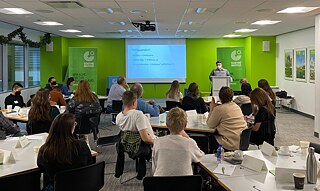Review: Professional development for German teachers on gender
Gender Equity and Sexual Diversity in the Classroom
With a humorous and thought-provoking insight into the way historical linguists have argued about grammatical gender in German, Dr. Sophie Salvo from the University of Chicago introduced a training for German teachers at the Goethe-Institut Chicago, held in collaboration with DAAD USA. The professional development training, titled "Gender Equity and Sexual Diversity in the Classroom," took place December 9-10, 2022, at the Goethe-Institut Chicago and was attended by 25 teachers from across the U.S., primarily from the Midwest.
In her talk "Heterosexual Nouns. The Masculinist Dreams of Nineteenth-Centruy Linguistics" on Friday evening, Dr. Sophie Salvo made it clear that there was initially no connection between the meaning of a word and its grammatical gender for linguistic scholars, but that this was understood as arbitrary. It was not until the 19th century that linguists sought semantic reasons for why, for example, a flower is feminine and a tree is masculine, with the reasoning reflecting binary notions of gender. Finally, with a look at the present and on the basis of political programs of German parties, the speaker showed how language continues to be ideologically charged and how other highly topical political issues are negotiated through it.
In the workshop on the second day of the training, Dr. Claire E. Scott from Vanderbilt University in Nashville, Tennessee, explored the topic of gender equity and sexual diversity in the classroom. Together with the participants, Dr. Claire E. Scott discussed the question of why and how gender and sexual diversity can be addressed in the German classroom.
The speaker presented different approaches to make simple tasks more inclusive as well as the findings of recent research and their implications for lesson design. Afterwards, the gender-inclusive variants of the gender asterisk and the gender gap were discussed and alternative pronouns such as xier were introduced and exemplified. When it came to approaching the topic in class, familiar situations and arguments were discussed and possible methods and solutions explored.
The next part of the workshop focused on teaching topics such as professions in which gendered forms of words are frequently used. The participants learned about neutral terms and dealt with gender-appropriate teaching materials. At the end, there was a lively exchange and mutual tips on how to implement what had been learned into German curricula. One result of the group discussion was that the topic of gender should appear as early as possible in the school curriculum, as many students are concerned about addressing themselves and others with the correct pronouns.
The participants' feedback on the training was thoroughly positive and shows how highly relevant the topic is and how much German teachers in the U.S. are interested in an exchange on it.
